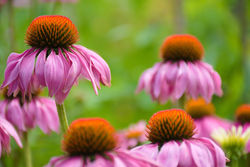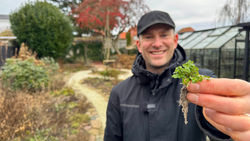What are the different soil types in a garden? Why are they important?
- Lars Wildes
- Jan 27, 2023
- 5 min read
Updated: May 14, 2023
Perennial gardening (or any type of gardening) isn’t just about choosing what flowers, fruits, or vegetables to grow. You also have to consider the soil that you’re working with.
The right type of soil will have the texture, structure, pH, electrical conductivity, and specific plant nutrients like nitrogen, phosphorus, and potassium that your plants and vegetables need to grow.
But don’t worry, you don’t have to pull out a microscope or call a geologist to determine the soil type in your garden. Here are 2 easy ways to determine the soil type.
First, look at the color of the soil.
Surface soil colors can vary from almost white to shades of brown, gray, and black
Light-colored soil indicates a low organic matter content
Dark colors usually mean your soil has higher organic content (better for growing)
Light or pale colors in the surface soil generally mean that the soil is more course and possibly leached of nutrients
Dark-colored soil can also mean that it’s very wet and holds a lot of water

How to do a soil ribbon test
You can also check the size of the particles in the soil. This will tell you if the soil you’re going to plant in is mostly sand, clay, or silt.
Take a small handful of soil.
Add enough water to make a ball. If you can’t make a ball, the soil is very sandy.
Feel the ball with your fingers to find out if it is gritty (sand), silky (silt), or sticky (clay).
Reshape the ball. Now, using your thumb, gently press it out over your forefinger to make a hanging ribbon.
If you can make a short ribbon, your soil texture is loamy, a mixture of sand and clay. That’s a good mix. It might even feel a little greasy because of the organic matter in it.
If you can’t make a ribbon, it has too much sand. If it's mostly sand, it won't hold as much water or nutrients as a mix of sand, silt, and clay.
If it forms a long ribbon, the soil has too much clay.
What does compost, topsoil, humus, composted soil, and other gardening soil types mean?
I get asked this question all of the time, and it’s easy to see why these different words confuse people.
Not to mention that humus sounds a lot like hummus. But trust me, they are very different and only ones tastes great with pita.
Compost is organic matter that has been broken down into a nutrient-rich soil helper — something that you add to your garden soil. It’s made by combining a variety of organic materials, such as leaves, grass clippings, and food scraps, and letting them decompose over time. If you leave compost alone, it will become humus.
Topsoil is the upper layer of soil. It’s usually rich in organic matter and nutrients, and this is the layer of soil that supports plant growth.
Humus is a type of organic matter that has been broken down by microorganisms and is rich in nutrients. It’s a major factor in healthy soil and helps to improve soil structure and water retention. Humus is what compost will become if you leave it alone for years and years.
Composted soil is a type of soil that has compost added. You’ll see it a lot in perennial gardening because it can improve soil fertility and structure.

What are the main types of soil that every beginner flower gardener should know
Whenever you look up a new plant or bring one home from the nursery, you’ll see one of these soil types on the instruction card.
Remember that you can check your garden’s soil type by using the ribbon technique above.
Sandy soil — Sandy soil is composed of large particles and drains quickly, but may be lacking in nutrients and may dry out quickly.
Clay soil — Clay soil is composed of small particles and retains moisture well, but it can be heavy and compacted, making it difficult for roots to penetrate.
Loamy soil — Loamy soil is a mixture of sand, clay, and organic matter. It has a good balance of drainage and moisture retention and is rich in nutrients. This type of soil is ideal for flower gardening.
Peaty soil — Peaty soil is composed of partially decomposed organic matter and can be very acidic. It’s commonly used as a soil additive to improve water retention and fertility.
Chalky soil — Chalky soil is composed of a high proportion of limestone and can be alkaline. It’s well-draining and can be improved by adding organic matter to increase fertility.
What perennials grow well in each soil type
Sandy soil
Black-eyed Susan (Rudbeckia hirta)

Butterfly weed (Asclepias tuberosa)

Blanket flower (Gaillardia grandiflora)

Want to see more low-growing perennials like the blanket flower? Click here.
Clay soil
Coneflower (Echinacea purpurea)

Gaillardia (Gaillardia pinnatifada)

Daylily (Hemerocallis spp.)

Loamy soil
Peony (Paeonia lactiflora)

Iris (Iris spp.)

Shasta Daisy (Leucanthemum x superbum)

Peaty soil
Cranesbill (Geranium spp.)

Heather (Calluna vulgaris)

Andromeda (Pieris japonica)

Chalky soil
Pinks (Dianthus spp.)

Bellflower (Campanula spp.)

Sedum (Sedum spp.)

Looking for more pink flowers? Find the best pink perennials here.
A quick note about the flowers above. These are just examples and many plants can adapt to different soil types as long as they are provided with the right conditions (water, light, etc.).
It is worth mentioning that most perennials prefer well-draining soil and usually don’t do well in heavy clay soil.
Garden soil troubleshooting
How can you easily improve garden soil?
The secret to improving garden soil, any garden soil, is to add composted organic matter.
If possible, you can also test your soil pH, which is ideally between 6.0–6.5.
If it is too acidic, add lime. If it is too basic, add organic sulfur.
How can you improve garden soil to make a kitchen garden?
First, add organic matter. An easy way to do that is to plant whatever you’re going to plant and then mulch around those plants.
The mulch will rot over time and become organic matter in the soil. The mulch that’s still on top of the soil will help keep weeds down and keep moisture in the soil beneath. Keep your soil covered as much as possible.
Secondly, don’t use herbicides or insecticides. These are poisons and can end up harming things you want in your soil like worms and mycorrhizal fungi, and helpful bacteria. The important things that break down organic matter on the surface of the soil and make it into Soil Organic Matter.
Soil Organic Matter (SOM) and a very active and healthy soil biome is what you need for a healthy garden.
Lastly, plant a variety of plants. This helps create more of a healthy soil biome.
These are general tips that work for most soil types. If you’re trying to grow something on pure sand, you’ll have to add more organic matter than someone working with richer soil already. Start with organic matter (compost) and you’re well on your way to a delicious kitchen garden.
How can you improve poor-quality garden soil without buying new dirt or compost?
Start by aerating it. Push the soil over with a hoe or fork — be sure to go deep. And keep it moist. This will encourage worms to return to the soil. (You can also add earthworms.)
Next, spread your lawn mowing and clippings (leaves, etc) into the soil and give the worms time to break it down.
You can also start making your own compost — grab any container and start adding layers of weeds, lawn mowings, prunings, shredded paper and cardboard, vegetables and fruit scraps from the kitchen, coffee grounds, etc.
If you don’t have space for a bin. You can also bury the things I just mentioned (focus more on the organic side, not so much cardboard) directly in your soil. Adding this layer of organic matter will take time to break down, but your soil will be much richer for it.









Comments